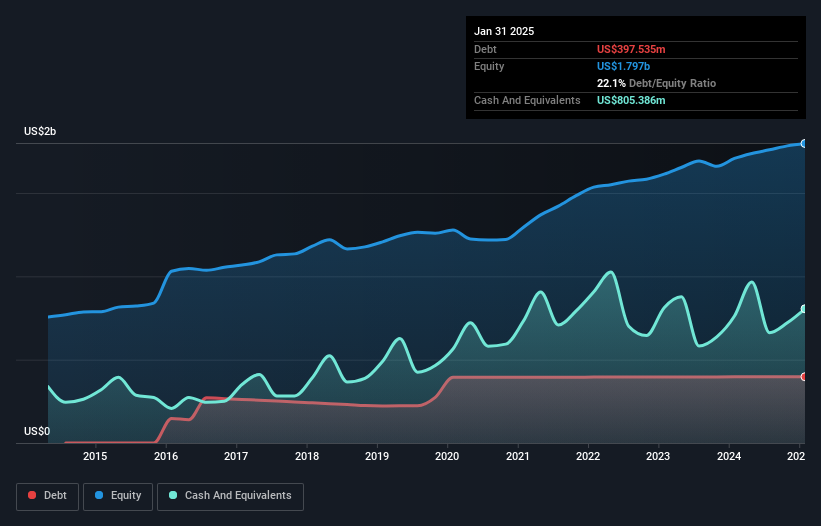Does Korn Ferry (NYSE:KFY) Have A Healthy Balance Sheet?
Warren Buffett famously said, 'Volatility is far from synonymous with risk.' It's only natural to consider a company's balance sheet when you examine how risky it is, since debt is often involved when a business collapses. We note that Korn Ferry (NYSE:KFY) does have debt on its balance sheet. But the real question is whether this debt is making the company risky.
We check all companies for important risks. See what we found for Korn Ferry in our free report.When Is Debt Dangerous?
Debt and other liabilities become risky for a business when it cannot easily fulfill those obligations, either with free cash flow or by raising capital at an attractive price. In the worst case scenario, a company can go bankrupt if it cannot pay its creditors. However, a more usual (but still expensive) situation is where a company must dilute shareholders at a cheap share price simply to get debt under control. Of course, the upside of debt is that it often represents cheap capital, especially when it replaces dilution in a company with the ability to reinvest at high rates of return. When we examine debt levels, we first consider both cash and debt levels, together.
What Is Korn Ferry's Debt?
The chart below, which you can click on for greater detail, shows that Korn Ferry had US$397.5m in debt in January 2025; about the same as the year before. But on the other hand it also has US$805.4m in cash, leading to a US$407.9m net cash position.

How Healthy Is Korn Ferry's Balance Sheet?
The latest balance sheet data shows that Korn Ferry had liabilities of US$817.8m due within a year, and liabilities of US$1.03b falling due after that. Offsetting these obligations, it had cash of US$805.4m as well as receivables valued at US$630.2m due within 12 months. So its liabilities total US$416.8m more than the combination of its cash and short-term receivables.
Of course, Korn Ferry has a market capitalization of US$3.30b, so these liabilities are probably manageable. Having said that, it's clear that we should continue to monitor its balance sheet, lest it change for the worse. While it does have liabilities worth noting, Korn Ferry also has more cash than debt, so we're pretty confident it can manage its debt safely.
View our latest analysis for Korn Ferry
And we also note warmly that Korn Ferry grew its EBIT by 19% last year, making its debt load easier to handle. When analysing debt levels, the balance sheet is the obvious place to start. But ultimately the future profitability of the business will decide if Korn Ferry can strengthen its balance sheet over time. So if you're focused on the future you can check out this free report showing analyst profit forecasts.
But our final consideration is also important, because a company cannot pay debt with paper profits; it needs cold hard cash. While Korn Ferry has net cash on its balance sheet, it's still worth taking a look at its ability to convert earnings before interest and tax (EBIT) to free cash flow, to help us understand how quickly it is building (or eroding) that cash balance. During the last three years, Korn Ferry generated free cash flow amounting to a very robust 82% of its EBIT, more than we'd expect. That positions it well to pay down debt if desirable to do so.
Summing Up
While Korn Ferry does have more liabilities than liquid assets, it also has net cash of US$407.9m. And it impressed us with free cash flow of US$316m, being 82% of its EBIT. So we don't think Korn Ferry's use of debt is risky. Another factor that would give us confidence in Korn Ferry would be if insiders have been buying shares: if you're conscious of that signal too, you can find out instantly by clicking this link.
When all is said and done, sometimes its easier to focus on companies that don't even need debt. Readers can access a list of growth stocks with zero net debt 100% free, right now.
Have feedback on this article? Concerned about the content? Get in touch with us directly. Alternatively, email editorial-team (at) simplywallst.com.
This article by Simply Wall St is general in nature. We provide commentary based on historical data and analyst forecasts only using an unbiased methodology and our articles are not intended to be financial advice. It does not constitute a recommendation to buy or sell any stock, and does not take account of your objectives, or your financial situation. We aim to bring you long-term focused analysis driven by fundamental data. Note that our analysis may not factor in the latest price-sensitive company announcements or qualitative material. Simply Wall St has no position in any stocks mentioned.
 Wall Street Journal
Wall Street Journal